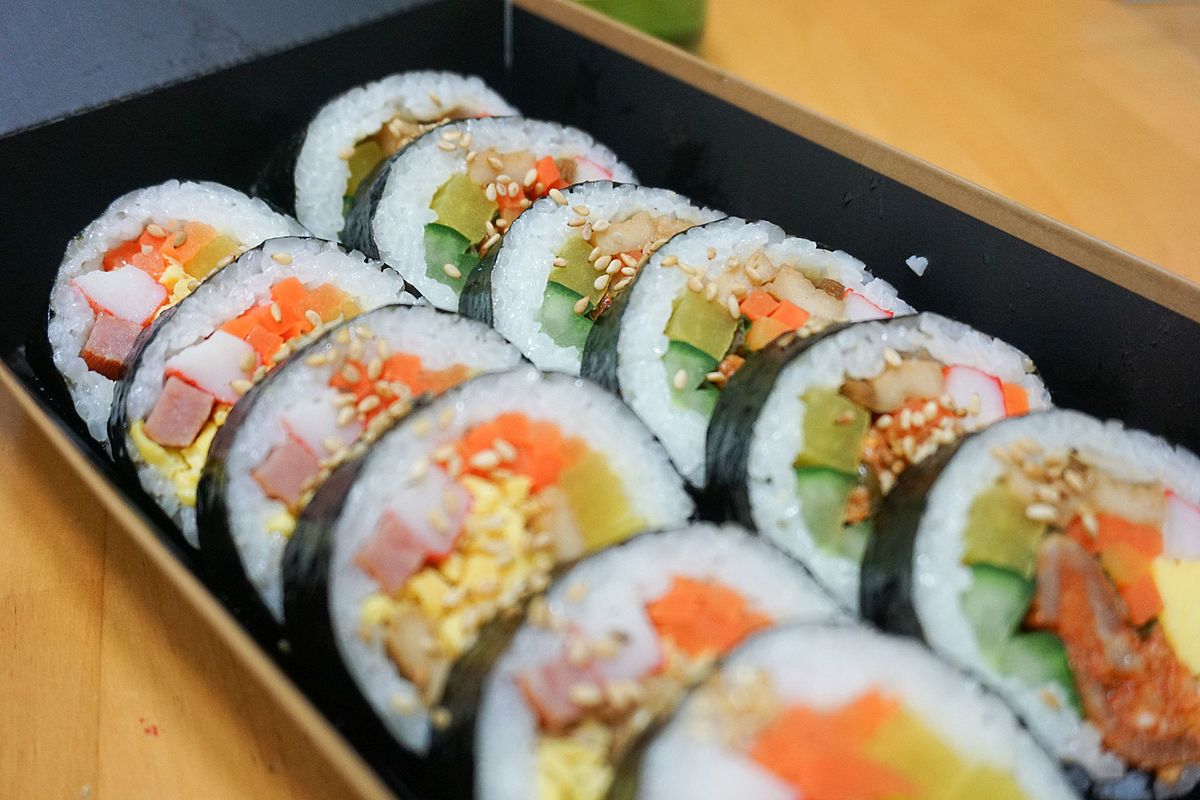Gimbap - Wikipedia
Your folders
Your folders

Ingredients
Export 1 ingredients for grocery delivery
Instructions
^ .mw-parser-output cite.citation{font-style:inherit}.mw-parser-output .citation q{quotes:"\"""\"""'""'"}.mw-parser-output .id-lock-free a,.mw-parser-output .citation .cs1-lock-free a{background:linear-gradient(transparent,transparent),url("//upload.wikimedia.org/wikipedia/commons/6/65/Lock-green.svg")right 0.1em center/9px no-repeat}.mw-parser-output .id-lock-limited a,.mw-parser-output .id-lock-registration a,.mw-parser-output .citation .cs1-lock-limited a,.mw-parser-output .citation .cs1-lock-registration a{background:linear-gradient(transparent,transparent),url("//upload.wikimedia.org/wikipedia/commons/d/d6/Lock-gray-alt-2.svg")right 0.1em center/9px no-repeat}.mw-parser-output .id-lock-subscription a,.mw-parser-output .citation .cs1-lock-subscription a{background:linear-gradient(transparent,transparent),url("//upload.wikimedia.org/wikipedia/commons/a/aa/Lock-red-alt-2.svg")right 0.1em center/9px no-repeat}.mw-parser-output .cs1-subscription,.mw-parser-output .cs1-registration{color:#555}.mw-parser-output .cs1-subscription span,.mw-parser-output .cs1-registration span{border-bottom:1px dotted;cursor:help}.mw-parser-output .cs1-ws-icon a{background:linear-gradient(transparent,transparent),url("//upload.wikimedia.org/wikipedia/commons/4/4c/Wikisource-logo.svg")right 0.1em center/12px no-repeat}.mw-parser-output code.cs1-code{color:inherit;background:inherit;border:none;padding:inherit}.mw-parser-output .cs1-hidden-error{display:none;font-size:100%}.mw-parser-output .cs1-visible-error{font-size:100%}.mw-parser-output .cs1-maint{display:none;color:#33aa33;margin-left:0.3em}.mw-parser-output .cs1-format{font-size:95%}.mw-parser-output .cs1-kern-left,.mw-parser-output .cs1-kern-wl-left{padding-left:0.2em}.mw-parser-output .cs1-kern-right,.mw-parser-output .cs1-kern-wl-right{padding-right:0.2em}.mw-parser-output .citation .mw-selflink{font-weight:inherit}National Institute of Korean Language (30 July 2014). "주요 한식명(200개) 로마자 표기 및 번역(영, 중, 일) 표준안" (PDF) (in Korean). Retrieved 15 February 2017. Lay summary – National Institute of Korean Language. ^ Levinson, David; Christensen, Karen (2002). Encyclopedia of Modern Asia: China-India relations to Hyogo. Charles Scribner's Sons. ISBN 0-684-80617-7. This process was initiated during the Japanese occupation (1910-1945), when Western food and drink, such as bread, confectionery, and beer, became popular in Korean cities, and a Western-style food processing industry in Korea began. Some Japanese food items were also adopted into Korean cuisine at that time, such as tosirak (the assorted lunch box) and sushi rolled in sheets of seaweed, which was popular in Korea under the name of kimbap. ^ Brunner, Anne (2011). Algas/ Algae: Sabores Marinos Para Cocinar/ Marine Flavors for Cooking (in Spanish). Editorial HISPANO EUROPEA. ISBN 978-84-255-1977-2. En Corea, los gimbaps son derivados de los maki sushis japoneses, pero generalmente estan rellenos de arroz con aceite de sesamo y carne. [In Korea, gimbaps are derived from the Japanese maki sushi, but they are usually stuffed with rice with sesame oil and meat.] ^ 김밥 [Gimbap] (in Korean). 한국민족문화대백과[Encyclopedia of Korean National Culture]. Archived from the original on 24 March 2012. 일본음식 김초밥에서 유래된 것으로 [(Gimbap is) derived from Japanese norimaki] ^ 국립국어연구원 [National Institute of Korean languages] (2002). 우리 문화 길라 잡이: 한국인 이 꼭 알아야할 전통 문화 233가지 [Guide To Our Culture: 233 kinds of Korean traditional culture for you to know] (in Korean). 학고재 [Hakgojae]. p. 479. ISBN 89-85846-97-3. 일본 음식인 김초밥 에서 유래 한 것으로 [(Gimbap is) derived from Japanese norimaki] ^ "김밥". terms.naver.com (in Korean). Retrieved 2021-04-04. ^ Alexander, Stian (21 January 2016). "UK's new favourite takeaway has been revealed - and it's not what you'd think". Daily Mirror. Retrieved 26 February 2017. ^ a b Kim, Maesun (1819). Yeoryang Sesigi 열양세시기(洌陽歲時記) [Records of Seasonal Festivities around the Capital]. Joseon Korea. ^ a b 박, 정배 (12 October 2016). "1819년엔 '福쌈'이라 불려… 이젠 프리미엄 김밥도". The Chosun Ilbo (in Korean). Retrieved 26 February 2017. ^ a b "휴지통". The Dong-a Ilbo (in Korean). 14 January 1935. Retrieved 26 February 2017 – via Naver. 문어 점복에 김밥을 싸먹고 목욕한후 바위등에 누으면 얼화만수—— ^ "노리마키(海苔卷)". National Institute of Korean Language (in Korean). Retrieved 27 February 2017. ^ a b "Kimbap: Colorful Korean Rolls Fit for a Picnic | Institute of Culinary Education". www.ice.edu. Retrieved 2021-03-06. ^ Levinson, David; Christensen, Karen (2002). Encyclopedia of Modern Asia: China-India relations to Hyogo. Charles Scribner's Sons. ISBN 0-684-80617-7. This process was initiated during the Japanese occupation (1910-1945), when Western food and drink, such as bread, confectionery, and beer, became popular in Korean cities, and a Western-style food processing industry in Korea began. Some Japanese food items were also adopted into Korean cuisine at that time, such as tosirak (the assorted lunch box) and sushi rolled in sheets of seaweed, which was popular in Korea under the name of kimbap. ^ Brunner, Anne (2011). Algas/ Algae: Sabores Marinos Para Cocinar/ Marine Flavors for Cooking (in Spanish). Editorial Hispano Europea. ISBN 978-84-255-1977-2. En Corea, los gimbaps son derivados de los maki sushis japoneses, pero generalmente estan rellenos de arroz con aceite de sesamo y carne. [In Korea, gimbaps are derived from the Japanese maki sushi, but they are usually stuffed with rice with sesame oil and meat.] ^ 김밥 [Gimbap] (in Korean). 한국민족문화대백과[Encyclopedia of Korean National Culture]. Archived from the original on 24 March 2012. 일본음식 김초밥에서 유래된 것으로 [(Gimbap is) derived from Japanese norimaki] ^ 국립국어연구원 [National Institute of Korean languages] (2002). 우리 문화 길라 잡이: 한국인 이 꼭 알아야할 전통 문화 233가지 [Guide To Our Culture: 233 kinds of Korean traditional culture for you to know] (in Korean). 학고재 [Hakgojae]. p. 479. ISBN 89-85846-97-3. 일본 음식인 김초밥 에서 유래 한 것으로 [(Gimbap is) derived from Japanese norimaki] ^ 日?フ?ズ株式?社 フ?ドジャ?ナリスト 平松洋子「日本から韓?へ?わった食べ物」 ^ 日本の太?きが由?で、近代以降に韓?でも食べられるようになりました。2005年5月13日 西日本新聞 ^ 김, 춘련 (18 August 2015). "gimbap" 김밥. Encyclopedia of Korean Culture (in Korean). Archived from the original on 25 March 2012. Retrieved 26 February 2017. ^ "What is the origin of kimbap?". behgopa. 2018-08-14. Retrieved 2021-03-06. ^ Ha, Yeon; Geum, Yu; Gim, Bin (1425). Gyeongsang-do Jiriji 경상도지리지(慶尙道地理志) [Geography of Gyeongsang Province] (in Korean). Joseon Korea. ^ Yi, Haeng (1530) [1481]. Sinjeung Dongguk Yeoji Seungnam 신증동국여지승람(新增東國輿地勝覽) [Revised and Augmented Survey of the Geography of Korea]. Joseon Korea. ^ Encyclopedia of modern Asia. David Levinson, Karen Christensen. New York: Charles Scribner's Sons. 2002. ISBN 0-684-80617-7. OCLC 49936055.CS1 maint: others (link) ^ Uri munhwa killa chabi : Han'gugin i kkok arayahal chŏnt'ong munhwa 233-kaji. Kungnip Kugŏ Yŏn'guwŏn, 국립 국어 연구원 (Ch'op'an ed.). Sŏul-si: Hakkojae. 2002. ISBN 89-85846-97-3. OCLC 51294057.CS1 maint: others (link) ^ Goldberg, Lina (23 March 2012). "Asia's 10 greatest street food cities". CNN. Retrieved 11 April 2012. ^ Cho, Joy (2021-01-03). "Kimbap: Colorful Korean rolls fit for a picnic". Salon. Retrieved 2021-04-13. ^ Kwak, Darun (2020-09-09). "Kimbap Recipe". NYT Cooking. Retrieved 2021-04-13. ^ "gimbap" 김밥. Korean Food Foundation. Retrieved 22 April 2017. ^ "Chungmu-gimbap" 충무김밥. Doopedia (in Korean). Doosan Corporation. Retrieved 19 May 2017. ^ Choi, Hyun-joo (18 May 2017). "Republic of convenience stores". Korea JoongAng Daily. Retrieved 19 May 2017. ^ "삼각김밥", 위키백과, 우리 모두의 백과사전 (in Korean), 2018-07-24, retrieved 2019-03-18 ^ 이, 창선 (5 December 2016). "[김밥 프랜차이즈 브랜드평판] 1위 김밥천국, 2위 고봉민김밥인, 3위 충무김밥". The Korea Financial Times (in Korean). Retrieved 20 May 2017.